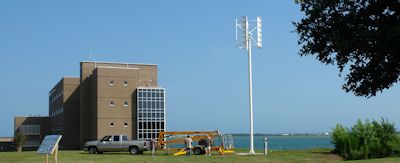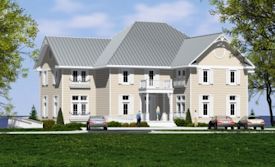 The vertical axis wind tower astride the CMAST building was designed and built by a N.C. company. Photo: GreenSky Wind Systems. |
MOREHEAD CITY — Crooked trees gracing the natural landscape in this coastal city and its neighboring beaches prompted one question.
If winds sweeping the coast can twist the trunks and branches of live oaks and yaupons, what could those same winds do when used as an alternative energy source?
Supporter Spotlight
Researchers at N.C. State University’s Center for Marine and Science Technology, or CMAST, in Morehead City are excited to get the answer from small-scale wind turbines.
In July, the center launched the use of a ZEPHYRE 1.2 kilowatt, vertical axis turbine, built by a North Carolina-based company that has created a turbine to rotate silently without vibration in 5 mph winds and engineered to withstand wind speeds up to 135 mph. These turbines can also be mounted onto rooftops.
The turbine at CMAST is fastened atop a 30-foot-tall post overlooking Bogue Sound. An educational billboard explains to passing motorists and boaters how the turbine works and its benefits.
“It’s been a great beacon for small-scale alternative energy,” said David Eggleston, a professor of marine science and the center’s director.
GreenSky Wind Systems, a small, start-up company out of Raleigh, agreed to collaborate with the university on the project. The N.C. Solar Center is gathering independent proficiency data as it monitors ZEPHYRE’s output.
Supporter Spotlight
 David Eggleston |
Eggleston said researchers will begin collecting quantitative data once Progress Energy installs a meter to track that data, which will be shared with the public in an effort to educate residents about efficient alternative energy sources.
“We view the turbine as just one more example of trying to illustrate sustainable living along the coast,” Eggleston said. “Eventually what will go on the west side of the turbine is a guest house.”
Fundraising efforts begin this month to build a house spanning more than 6,000 square feet for visiting students, faculty and staff.
The turbine, designed to meet one quarter to one-third of annual electricity demand in one house, would power the much-needed addition to the campus, particularly during peak tourism summer months when it’s difficult to find short-term housing, Eggleston said.
He hopes to find a donor to fund the purchase of a 1.2 kilowatt solar array to install on campus, allowing researchers to further study which alternative energy – wind or solar – is the most efficient.
“We want to be able to help people make an educated decision when they’re looking at alternative energy,” Eggleston said.
In March, the center began tracking energy production from a 35-foot-tall, 10 kW turbine installed next to a 10 kW solar array in Smyrna, a small community nestled along Core Sound in eastern Carteret County.
“I view it as a foot race,” Eggleston said. “Right now the solar panels are outdoing the wind energy.”
But winds generally pick up during this time of year and, as fall approaches and daylight savings comes to an end, he could see a change, he said.
 The wind tower is expected to supply power to a house for students and faculty that N.C. State hopes to build near the CMAST building. Artist’s rendering by MBF Architects. |
As research continues, perceptions about alternative energy are changing in the coastal communities in which Eggleston works.
When he went before the local planning board to obtain a variance to have the 10 kW turbine installed, more than 20 locals showed up in opposition to his request, Eggleston said.
Months after he received the variance, he had to return to the town for additional local feedback.
“What was interesting was that this time there wasn’t a single person who showed up against it,” Eggleston said. “The comments we’re getting now are, ‘That’s cool. It’s beautiful.’ As people see these turbines and get accustomed to them, I think it’s just starting to change the perception of, certainly, small-scale energy.”
That’s a big step considering there are entire Web sites dedicated to turning the public against wind turbine technology.
GreenSky has spent the past five years developing a system that addresses some of the major complaints about turbines, said Quentin Ankri, company co-founder and president.
Vertical axis turbines reduce noise and they eliminate the problem of “white light,” a phenomenon where birds, which followed insects attracted to the color of the spinning blades, get injured or killed when they fly into the blades. The company also builds its own generators rather than import them from China, Ankri said.
GreenSky customers are home and business owners, as well as farmers, who have the benefit of open fields with no wind disruption and can use the technology to power everything from water pumps to electrical fencing.
The cost – between $16,000 and $18,000 per unit – should pay the customer back anywhere from six to eight years, Ankri said. Customers receive a 30 percent federal tax credit. North Carolina offers a 35 percent tax credit.
“We finally got to a point where we’re very proud of our technology,” Ankri said. “It’s been in California, in Colorado. We want to show people that we have this technology right here in North Carolina. We know that this technology will make a difference.”








